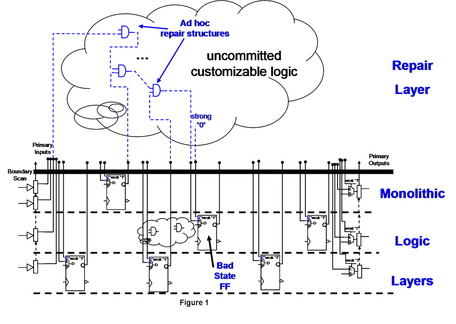
We have a guest contribution today from Ze'ev Wurman, MonolithIC 3D Inc.'s Chief Software Architect. Ze'ev discusses yield issues with 3D stacked chips.
Turns out that such simplistic approach does not have to be right. In fact, we will see that a clever use of monolithic stacking allows us to increase the yield, and reliably manufacture much bigger devices than previously possible.
The basic idea behind yield improvement in monolithic 3D is the concept of repair. We are familiar with this concept from big memory arrays, where we create spare rows or columns, and switch them in as needed using some form of programming to replace faulty memory elements. This works for memory arrays because they are designed to have uniform access time across the whole array, and replacing one column by another that is physically located elsewhere makes no functional difference. In logic terrain, however, this is effectively impossible. Many logic paths are finely tuned and have little slack. Replacing a faulty element in such path with another, which may be far away from the location of the original element, is bound to fail because of the additional delay that is introduced.
This picture changes with monolithic 3D design. We can design our logic on N layers, and we can then place an additional (N+1) layer on top of the stack, dedicated to the repair of the layers below. One example of such architecture is schematically depicted below.
We have described here one repair architecture, but others are possible. The key point to remember is that with multi-layer stacking we can afford to have silicon dedicated to repair right above where any potential logic fault can occur.
Before I finish this post, let me touch on another intriguing possibility. Thirty years ago Gene Amdahl gave up on his dream of wafer-scale integration, when he realized that the yields needed for a wafer-scale device will not be attainable for perhaps another 100 years. Yet monolithic 3D stacking with a repair layer brings Amdahl’s dream within our reach. After all, with a repair capability on a logic cone-by-cone basis, nothing stops us from achieving close to 100% yield even at the level of a full wafer.









 RSS Feed
RSS Feed